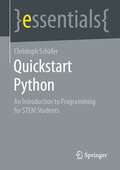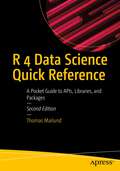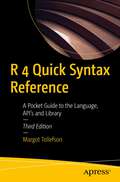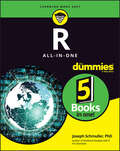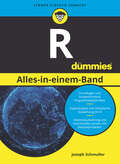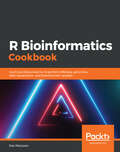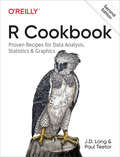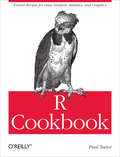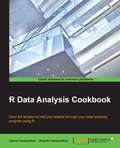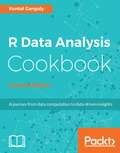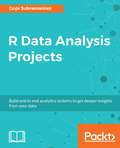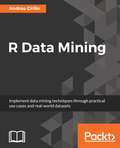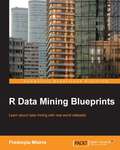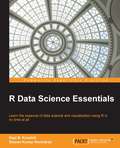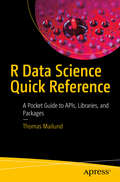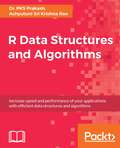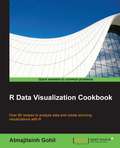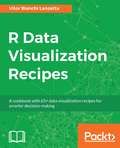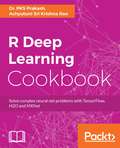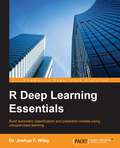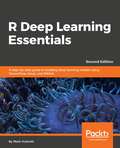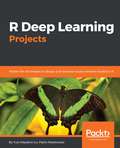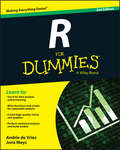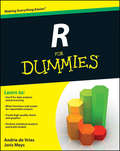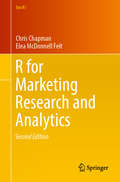- Table View
- List View
Quickstart Python: An Introduction to Programming for STEM Students (essentials)
by Christoph SchäferChristoph Schäfer introduces the great world of programming with Python and provides a quick introduction to independent script development. He points out how the programming language Python has established itself in recent years alongside MATLAB and R as a standard at scientific workplaces in research and development, and shows that the great popularity of Python is based on its easy extensibility: It is very easy to use modules from other developers in your own scripts and programs. In particular, the author presents the modules NumPy, SciPy and Matplotlib, which offer scientists and engineers a perfect development environment for scientific and technical computing, for applications in physics, chemistry, biology and computer science. Python is also used in the latest applications in the highly topical fields of Big Data Science and Machine Learning. The author: Dr. Christoph Schäfer teaches and researches in the Department of Computational Physics at the Institute of Astronomy and Astrophysics at the Eberhard Karls University of Tübingen. This Springer essential is a translation of the original German 1st edition essentials, Schnellstart Python by Christoph Schäfer, published by Springer Fachmedien Wiesbaden GmbH, part of Springer Nature in 2019. The translation was done with the help of artificial intelligence (machine translation by the service DeepL.com). A subsequent human revision was done primarily in terms of content, so that the book will read stylistically differently from a conventional translation. Springer Nature works continuously to further the development of tools for the production of books and on the related technologies to support the authors.
R 4 Data Science Quick Reference: A Pocket Guide to APIs, Libraries, and Packages
by Thomas MailundIn this handy, quick reference book you'll be introduced to several R data science packages, with examples of how to use each of them. All concepts will be covered concisely, with many illustrative examples using the following APIs: readr, dibble, forecasts, lubridate, stringr, tidyr, magnittr, dplyr, purrr, ggplot2, modelr, and more.With R 4 Data Science Quick Reference, you'll have the code, APIs, and insights to write data science-based applications in the R programming language. You'll also be able to carry out data analysis. All source code used in the book is freely available on GitHub.. What You'll LearnImplement applicable R 4 programming language specification featuresImport data with readrWork with categories using forcats, time and dates with lubridate, and strings with stringrFormat data using tidyr and then transform that data using magrittr and dplyrWrite functions with R for data science, data mining, and analytics-based applicationsVisualize data with ggplot2 and fit data to models using modelrWho This Book Is ForProgrammers new to R's data science, data mining, and analytics packages. Some prior coding experience with R in general is recommended.
R 4 Quick Syntax Reference: A Pocket Guide to the Language, API's and Library
by Margot TollefsonThis handy reference book detailing the intricacies of R covers version 4.x features, including numerous and significant changes to syntax, strings, reference counting, grid units, and more.Starting with the basic structure of R, the book takes you on a journey through the terminology used in R and the syntax required to make R work. You will find looking up the correct form for an expression quick and easy. Some of the new material includes information on RStudio, S4 syntax, working with character strings, and an example using the Twitter API.With a copy of the R 4 Quick Syntax Reference in hand, you will find that you are able to use the multitude of functions available in R and are even able to write your own functions to explore and analyze data.What You Will LearnDiscover the modes and classes of R objects and how to use themUse both packaged and user-created functions in R Import/export data and create new data objects in RCreate descriptive functions and manipulate objects in RTake advantage of flow control and conditional statementsWork with packages such as base, stats, and graphicsWho This Book Is ForThose with programming experience, either new to R, or those with at least some exposure to R but who are new to the latest version.
R All-in-One For Dummies
by Joseph SchmullerA deep dive into the programming language of choice for statistics and data With R All-in-One For Dummies, you get five mini-books in one, offering a complete and thorough resource on the R programming language and a road map for making sense of the sea of data we’re all swimming in. Maybe you’re pursuing a career in data science, maybe you’re looking to infuse a little statistics know-how into your existing career, or maybe you’re just R-curious. This book has your back. Along with providing an overview of coding in R and how to work with the language, this book delves into the types of projects and applications R programmers tend to tackle the most. You’ll find coverage of statistical analysis, machine learning, and data management with R. Grasp the basics of the R programming language and write your first lines of code Understand how R programmers use code to analyze data and perform statistical analysis Use R to create data visualizations and machine learning programs Work through sample projects to hone your R coding skill This is an excellent all-in-one resource for beginning coders who'd like to move into the data space by knowing more about R.
R Alles-in-einem-Band für Dummies (Für Dummies)
by Joseph SchmullerWenn Sie R von Grund auf kennenlernen und auch die fortgeschrittenen Techniken zur Lösung gängiger Aufgaben bei der Datenanalyse mit R beherrschen möchten, dann liegen Sie mit diesem Buch goldrichtig. Es bietet Ihnen nicht nur einen Überblick über die Programmierung in R und die Arbeit mit der Sprache, sondern geht auch auf die Arten von Projekten und Anwendungen ein, die R-Entwicklerinnen und -Entwickler häufig in Angriff nehmen müssen. Statistische Analysen, Datenvisualisierungen, maschinelles Lernen und Datenmanagement mit R: All das lernen Sie mit diesem Buch intensiv kennen.
R Bioinformatics Cookbook: Use R and Bioconductor to perform RNAseq, genomics, data visualization, and bioinformatic analysis
by Dan MacLeanOver 60 recipes to model and handle real-life biological data using modern libraries from the R ecosystem Key Features Apply modern R packages to handle biological data using real-world examples Represent biological data with advanced visualizations suitable for research and publications Handle real-world problems in bioinformatics such as next-generation sequencing, metagenomics, and automating analyses Book Description Handling biological data effectively requires an in-depth knowledge of machine learning techniques and computational skills, along with an understanding of how to use tools such as edgeR and DESeq. With the R Bioinformatics Cookbook, you'll explore all this and more, tackling common and not-so-common challenges in the bioinformatics domain using real-world examples. This book will use a recipe-based approach to show you how to perform practical research and analysis in computational biology with R. You will learn how to effectively analyze your data with the latest tools in Bioconductor, ggplot, and tidyverse. The book will guide you through the essential tools in Bioconductor to help you understand and carry out protocols in RNAseq, phylogenetics, genomics, and sequence analysis. As you progress, you will get up to speed with how machine learning techniques can be used in the bioinformatics domain. You will gradually develop key computational skills such as creating reusable workflows in R Markdown and packages for code reuse. By the end of this book, you'll have gained a solid understanding of the most important and widely used techniques in bioinformatic analysis and the tools you need to work with real biological data. What you will learn Employ Bioconductor to determine differential expressions in RNAseq data Run SAMtools and develop pipelines to find single nucleotide polymorphisms (SNPs) and Indels Use ggplot to create and annotate a range of visualizations Query external databases with Ensembl to find functional genomics information Execute large-scale multiple sequence alignment with DECIPHER to perform comparative genomics Use d3.js and Plotly to create dynamic and interactive web graphics Use k-nearest neighbors, support vector machines and random forests to find groups and classify data Who this book is for This book is for bioinformaticians, data analysts, researchers, and R developers who want to address intermediate-to-advanced biological and bioinformatics problems by learning through a recipe-based approach. Working knowledge of R programming language and basic knowledge of bioinformatics are prerequisites.
R Cookbook: Proven Recipes for Data Analysis, Statistics, and Graphics (Cookbook Ser.)
by Paul Teetor Jd LongPerform data analysis with R quickly and efficiently with more than 275 practical recipes in this expanded second edition. The R language provides everything you need to do statistical work, but its structure can be difficult to master. These task-oriented recipes make you productive with R immediately. Solutions range from basic tasks to input and output, general statistics, graphics, and linear regression.Each recipe addresses a specific problem and includes a discussion that explains the solution and provides insight into how it works. If you’re a beginner, R Cookbook will help get you started. If you’re an intermediate user, this book will jog your memory and expand your horizons. You’ll get the job done faster and learn more about R in the process.Create vectors, handle variables, and perform basic functionsSimplify data input and outputTackle data structures such as matrices, lists, factors, and data framesWork with probability, probability distributions, and random variablesCalculate statistics and confidence intervals and perform statistical testsCreate a variety of graphic displaysBuild statistical models with linear regressions and analysis of variance (ANOVA)Explore advanced statistical techniques, such as finding clusters in your data
R Cookbook: Proven Recipes for Data Analysis, Statistics, and Graphics (Cookbook Ser.)
by Paul TeetorWith more than 200 practical recipes, this book helps you perform data analysis with R quickly and efficiently. The R language provides everything you need to do statistical work, but its structure can be difficult to master. This collection of concise, task-oriented recipes makes you productive with R immediately, with solutions ranging from basic tasks to input and output, general statistics, graphics, and linear regression. Each recipe addresses a specific problem, with a discussion that explains the solution and offers insight into how it works. If you're a beginner, R Cookbook will help get you started. If you're an experienced data programmer, it will jog your memory and expand your horizons. You'll get the job done faster and learn more about R in the process. Create vectors, handle variables, and perform other basic functions Input and output data Tackle data structures such as matrices, lists, factors, and data frames Work with probability, probability distributions, and random variables Calculate statistics and confidence intervals, and perform statistical tests Create a variety of graphic displays Build statistical models with linear regressions and analysis of variance (ANOVA) Explore advanced statistical techniques, such as finding clusters in your data "Wonderfully readable, R Cookbook serves not only as a solutions manual of sorts, but as a truly enjoyable way to explore the R language--one practical example at a time." --Jeffrey Ryan, software consultant and R package author
R Data Analysis Cookbook
by Shanthi Viswanathan Viswa ViswanathanThis book is ideal for those who are already exposed to R, but have not yet used it extensively for data analytics and are seeking to get up and running quickly for analytics tasks. This book will help people who aspire to enhance their skills in any of the following ways: * perform advanced analyses and create informative and professional charts * become proficient in acquiring data from many sources * apply supervised and unsupervised data mining techniques * use R's features to present analyses professionally
R Data Analysis Cookbook - Second Edition
by Kuntal GangulyOver 80 recipes to help you breeze through your data analysis projects using R About This Book • Analyse your data using the popular R packages like ggplot2 with ready-to-use and customizable recipes • Find meaningful insights from your data and generate dynamic reports • A practical guide to help you put your data analysis skills in R to practical use Who This Book Is For This book is for data scientists, analysts and even enthusiasts who want to learn and implement the various data analysis techniques using R in a practical way. Those looking for quick, handy solutions to common tasks and challenges in data analysis will find this book to be very useful. Basic knowledge of statistics and R programming is assumed. What You Will Learn • Acquire, format and visualize your data using R • Using R to perform an Exploratory data analysis • Introduction to machine learning algorithms such as classification and regression • Get started with social network analysis • Generate dynamic reporting with Shiny • Get started with geospatial analysis • Handling large data with R using Spark and MongoDB • Build Recommendation system- Collaborative Filtering, Content based and Hybrid • Learn real world dataset examples- Fraud Detection and Image Recognition In Detail Data analytics with R has emerged as a very important focus for organizations of all kinds. R enables even those with only an intuitive grasp of the underlying concepts, without a deep mathematical background, to unleash powerful and detailed examinations of their data. This book will show you how you can put your data analysis skills in R to practical use, with recipes catering to the basic as well as advanced data analysis tasks. Right from acquiring your data and preparing it for analysis to the more complex data analysis techniques, the book will show you how you can implement each technique in the best possible manner. You will also visualize your data using the popular R packages like ggplot2 and gain hidden insights from it. Starting with implementing the basic data analysis concepts like handling your data to creating basic plots, you will master the more advanced data analysis techniques like performing cluster analysis, and generating effective analysis reports and visualizations. Throughout the book, you will get to know the common problems and obstacles you might encounter while implementing each of the data analysis techniques in R, with ways to overcoming them in the easiest possible way. By the end of this book, you will have all the knowledge you need to become an expert in data analysis with R, and put your skills to test in real-world scenarios. Style and Approach • Hands-on recipes to walk through data science challenges using R • Your one-stop solution for common and not-so-common pain points while performing real-world problems to execute a series of tasks. • Addressing your common and not-so-common pain points, this is a book that you must have on the shelf
R Data Analysis Projects
by Gopi SubramanianGet valuable insights from your data by building data analysis systems from scratch with R. About This Book • A handy guide to take your understanding of data analysis with R to the next level • Real-world projects that focus on problems in finance, network analysis, social media, and more • From data manipulation to analysis to visualization in R, this book will teach you everything you need to know about building end-to-end data analysis pipelines using R Who This Book Is For If you are looking for a book that takes you all the way through the practical application of advanced and effective analytics methodologies in R, then this is the book for you. A fundamental understanding of R and the basic concepts of data analysis is all you need to get started with this book. What You Will Learn • Build end-to-end predictive analytics systems in R • Build an experimental design to gather your own data and conduct analysis • Build a recommender system from scratch using different approaches • Use and leverage RShiny to build reactive programming applications • Build systems for varied domains including market research, network analysis, social media analysis, and more • Explore various R Packages such as RShiny, ggplot, recommenderlab, dplyr, and find out how to use them effectively • Communicate modeling results using Shiny Dashboards • Perform multi-variate time-series analysis prediction, supplemented with sensitivity analysis and risk modeling In Detail R offers a large variety of packages and libraries for fast and accurate data analysis and visualization. As a result, it's one of the most popularly used languages by data scientists and analysts, or anyone who wants to perform data analysis. This book will demonstrate how you can put to use your existing knowledge of data analysis in R to build highly efficient, end-to-end data analysis pipelines without any hassle. You'll start by building a content-based recommendation system, followed by building a project on sentiment analysis with tweets. You'll implement time-series modeling for anomaly detection, and understand cluster analysis of streaming data. You'll work through projects on performing efficient market data research, building recommendation systems, and analyzing networks accurately, all provided with easy to follow codes. With the help of these real-world projects, you'll get a better understanding of the challenges faced when building data analysis pipelines, and see how you can overcome them without compromising on the efficiency or accuracy of your systems. The book covers some popularly used R packages such as dplyr, ggplot2, RShiny, and others, and includes tips on using them effectively. By the end of this book, you'll have a better understanding of data analysis with R, and be able to put your knowledge to practical use without any hassle. Style and approach This book takes a unique, learn-as-you-do approach, as you build on your understanding of data analysis progressively with each project. This book is designed in a way that implementing each project will empower you with a unique skill set, and enable you to implement the next project more confidently.
R Data Mining
by Andrea CirilloMine valuable insights from your data using popular tools and techniques in R About This Book • Understand the basics of data mining and why R is a perfect tool for it. • Manipulate your data using popular R packages such as ggplot2, dplyr, and so on to gather valuable business insights from it. • Apply effective data mining models to perform regression and classification tasks. Who This Book Is For If you are a budding data scientist, or a data analyst with a basic knowledge of R, and want to get into the intricacies of data mining in a practical manner, this is the book for you. No previous experience of data mining is required. What You Will Learn • Master relevant packages such as dplyr, ggplot2 and so on for data mining • Learn how to effectively organize a data mining project through the CRISP-DM methodology • Implement data cleaning and validation tasks to get your data ready for data mining activities • Execute Exploratory Data Analysis both the numerical and the graphical way • Develop simple and multiple regression models along with logistic regression • Apply basic ensemble learning techniques to join together results from different data mining models • Perform text mining analysis from unstructured pdf files and textual data • Produce reports to effectively communicate objectives, methods, and insights of your analyses In Detail R is widely used to leverage data mining techniques across many different industries, including finance, medicine, scientific research, and more. This book will empower you to produce and present impressive analyses from data, by selecting and implementing the appropriate data mining techniques in R. It will let you gain these powerful skills while immersing in a one of a kind data mining crime case, where you will be requested to help resolving a real fraud case affecting a commercial company, by the mean of both basic and advanced data mining techniques. While moving along the plot of the story you will effectively learn and practice on real data the various R packages commonly employed for this kind of tasks. You will also get the chance of apply some of the most popular and effective data mining models and algos, from the basic multiple linear regression to the most advanced Support Vector Machines. Unlike other data mining learning instruments, this book will effectively expose you the theory behind these models, their relevant assumptions and when they can be applied to the data you are facing. By the end of the book you will hold a new and powerful toolbox of instruments, exactly knowing when and how to employ each of them to solve your data mining problems and get the most out of your data. Finally, to let you maximize the exposure to the concepts described and the learning process, the book comes packed with a reproducible bundle of commented R scripts and a practical set of data mining models cheat sheets. Style and approach This book takes a practical, step-by-step approach to explain the concepts of data mining. Practical use-cases involving real-world datasets are used throughout the book to clearly explain theoretical concepts.
R Data Mining Blueprints
by Pradeepta MishraLearn about data mining with real-world datasets About This Book * Diverse real-world datasets to teach data mining techniques * Practical and focused on real-world data mining cases, this book covers concepts such as spatial data mining, text mining, social media mining, and web mining * Real-world case studies illustrate various data mining techniques, taking you from novice to intermediate Who This Book Is For Data analysts from beginner to intermediate level who need a step-by-step helping hand in developing complex data mining projects are the ideal audience for this book. They should have prior knowledge of basic statistics and little bit of programming language experience in any tool or platform. What You Will Learn * Make use of statistics and programming to learn data mining concepts and its applications * Use R Programming to apply statistical models on data * Create predictive models to be applied for performing classification, prediction and recommendation * Use of various libraries available on R CRAN (comprehensive R archives network) in data mining * Apply data management steps in handling large datasets * Learn various data visualization libraries available in R for representing data * Implement various dimension reduction techniques to handle large datasets * Acquire knowledge about neural network concept drawn from computer science and its applications in data mining In Detail The R language is a powerful open source functional programming language. At its core, R is a statistical programming language that provides impressive tools for data mining and analysis. It enables you to create high-level graphics and offers an interface to other languages. This means R is best suited to produce data and visual analytics through customization scripts and commands, instead of the typical statistical tools that provide tick boxes and drop-down menus for users. This book explores data mining techniques and shows you how to apply different mining concepts to various statistical and data applications in a wide range of fields. We will teach you about R and its application to data mining, and give you relevant and useful information you can use to develop and improve your applications. It will help you complete complex data mining cases and guide you through handling issues you might encounter during projects. Style and approach This fast-paced guide will help you solve predictive modeling problems using the most popular data mining algorithms through simple, practical cases.
R Data Science Essentials
by Sharan Kumar Ravindran Raja B. KoushikLearn the essence of data science and visualization using R in no time at allAbout This BookBecome a pro at making stunning visualizations and dashboards quickly and without hassleFor better decision making in business, apply the R programming language with the help of useful statistical techniques.From seasoned authors comes a book that offers you a plethora of fast-paced techniques to detect and analyze data patternsWho This Book Is ForIf you are an aspiring data scientist or analyst who has a basic understanding of data science and has basic hands-on experience in R or any other analytics tool, then R Data Science Essentials is the book for you.What You Will LearnPerform data preprocessing and basic operations on dataImplement visual and non-visual implementation data exploration techniquesMine patterns from data using affinity and sequential analysisUse different clustering algorithms and visualize themImplement logistic and linear regression and find out how to evaluate and improve the performance of an algorithmExtract patterns through visualization and build a forecasting algorithmBuild a recommendation engine using different collaborative filtering algorithmsMake a stunning visualization and dashboard using ggplot and R shinyIn DetailWith organizations increasingly embedding data science across their enterprise and with management becoming more data-driven it is an urgent requirement for analysts and managers to understand the key concept of data science. The data science concepts discussed in this book will help you make key decisions and solve the complex problems you will inevitably face in this new world.R Data Science Essentials will introduce you to various important concepts in the field of data science using R. We start by reading data from multiple sources, then move on to processing the data, extracting hidden patterns, building predictive and forecasting models, building a recommendation engine, and communicating to the user through stunning visualizations and dashboards.By the end of this book, you will have an understanding of some very important techniques in data science, be able to implement them using R, understand and interpret the outcomes, and know how they helps businesses make a decision.Style and approachThis easy-to-follow guide contains hands-on examples of the concepts of data science using R.
R Data Science Quick Reference: A Pocket Guide to APIs, Libraries, and Packages
by Thomas MailundIn this handy, practical book you will cover each concept concisely, with many illustrative examples. You'll be introduced to several R data science packages, with examples of how to use each of them. In this book, you’ll learn about the following APIs and packages that deal specifically with data science applications: readr, dibble, forecasts, lubridate, stringr, tidyr, magnittr, dplyr, purrr, ggplot2, modelr, and more.After using this handy quick reference guide, you'll have the code, APIs, and insights to write data science-based applications in the R programming language. You'll also be able to carry out data analysis. What You Will LearnImport data with readrWork with categories using forcats, time and dates with lubridate, and strings with stringrFormat data using tidyr and then transform that data using magrittr and dplyrWrite functions with R for data science, data mining, and analytics-based applicationsVisualize data with ggplot2 and fit data to models using modelrWho This Book Is ForProgrammers new to R's data science, data mining, and analytics packages. Some prior coding experience with R in general is recommended.
R Data Structures and Algorithms
by Achyutuni Sri Rao Dr Pks PrakashIncrease speed and performance of your applications with efficient data structures and algorithms About This Book * See how to use data structures such as arrays, stacks, trees, lists, and graphs through real-world examples * Find out about important and advanced data structures such as searching and sorting algorithms * Understand important concepts such as big-o notation, dynamic programming, and functional data structured Who This Book Is For This book is for R developers who want to use data structures efficiently. Basic knowledge of R is expected. What You Will Learn * Understand the rationality behind data structures and algorithms * Understand computation evaluation of a program featuring asymptotic and empirical algorithm analysis * Get to know the fundamentals of arrays and linked-based data structures * Analyze types of sorting algorithms * Search algorithms along with hashing * Understand linear and tree-based indexing * Be able to implement a graph including topological sort, shortest path problem, and Prim's algorithm * Understand dynamic programming (Knapsack) and randomized algorithms In Detail In this book, we cover not only classical data structures, but also functional data structures. We begin by answering the fundamental question: why data structures? We then move on to cover the relationship between data structures and algorithms, followed by an analysis and evaluation of algorithms. We introduce the fundamentals of data structures, such as lists, stacks, queues, and dictionaries, using real-world examples. We also cover topics such as indexing, sorting, and searching in depth. Later on, you will be exposed to advanced topics such as graph data structures, dynamic programming, and randomized algorithms. You will come to appreciate the intricacies of high performance and scalable programming using R. We also cover special R data structures such as vectors, data frames, and atomic vectors. With this easy-to-read book, you will be able to understand the power of linked lists, double linked lists, and circular linked lists. We will also explore the application of binary search and will go in depth into sorting algorithms such as bubble sort, selection sort, insertion sort, and merge sort. Style and approach This easy-to-read book with its fast-paced nature will improve the productivity of an R programmer and improve the performance of R applications. It is packed with real-world examples.
R Data Visualization Cookbook
by Atmajitsinh GohilIf you are a data journalist, academician, student or freelance designer who wants to learn about data visualization, this book is for you. Basic knowledge of R programming is expected.
R Data Visualization Recipes
by Vitor Bianchi LanzettaTranslate your data into info-graphics using popular packages in R About This Book • Use R's popular packages—such as ggplot2, ggvis, ggforce, and more—to create custom, interactive visualization solutions. • Create, design, and build interactive dashboards using Shiny • A highly practical guide to help you get to grips with the basics of data visualization techniques, and how you can implement them using R Who This Book Is For If you are looking to create custom data visualization solutions using the R programming language and are stuck somewhere in the process, this book will come to your rescue. Prior exposure to packages such as ggplot2 would be useful but not necessary. However, some R programming knowledge is required. What You Will Learn • Get to know various data visualization libraries available in R to represent data • Generate elegant codes to craft graphics using ggplot2, ggvis and plotly • Add elements, text, animation, and colors to your plot to make sense of data • Deepen your knowledge by adding bar-charts, scatterplots, and time series plots using ggplot2 • Build interactive dashboards using Shiny. • Color specific map regions based on the values of a variable in your data frame • Create high-quality journal-publishable scatterplots • Create and design various three-dimensional and multivariate plots In Detail R is an open source language for data analysis and graphics that allows users to load various packages for effective and better data interpretation. Its popularity has soared in recent years because of its powerful capabilities when it comes to turning different kinds of data into intuitive visualization solutions. This book is an update to our earlier R data visualization cookbook with 100 percent fresh content and covering all the cutting edge R data visualization tools. This book is packed with practical recipes, designed to provide you with all the guidance needed to get to grips with data visualization using R. It starts off with the basics of ggplot2, ggvis, and plotly visualization packages, along with an introduction to creating maps and customizing them, before progressively taking you through various ggplot2 extensions, such as ggforce, ggrepel, and gganimate. Using real-world datasets, you will analyze and visualize your data as histograms, bar graphs, and scatterplots, and customize your plots with various themes and coloring options. The book also covers advanced visualization aspects such as creating interactive dashboards using Shiny By the end of the book, you will be equipped with key techniques to create impressive data visualizations with professional efficiency and precision. Style and approach This book is packed with practical recipes, designed to provide you with all the guidance needed to get to grips with data visualization with R. You will learn to leverage the power of R and ggplot2 to create highly customizable data visualizations of varying complexities. The readers will then learn how to create, design, and build interactive dashboards using Shiny.
R Deep Learning Cookbook
by Achyutuni Sri Rao Dr Pks PrakashPowerful, independent recipes to build deep learning models in different application areas using R libraries About This Book • Master intricacies of R deep learning packages such as mxnet & tensorflow • Learn application on deep learning in different domains using practical examples from text, image and speech • Guide to set-up deep learning models using CPU and GPU Who This Book Is For Data science professionals or analysts who have performed machine learning tasks and now want to explore deep learning and want a quick reference that could address the pain points while implementing deep learning. Those who wish to have an edge over other deep learning professionals will find this book quite useful. What You Will Learn • Build deep learning models in different application areas using TensorFlow, H2O, and MXnet. • Analyzing a Deep boltzmann machine • Setting up and Analysing Deep belief networks • Building supervised model using various machine learning algorithms • Set up variants of basic convolution function • Represent data using Autoencoders. • Explore generative models available in Deep Learning. • Discover sequence modeling using Recurrent nets • Learn fundamentals of Reinforcement Leaning • Learn the steps involved in applying Deep Learning in text mining • Explore application of deep learning in signal processing • Utilize Transfer learning for utilizing pre-trained model • Train a deep learning model on a GPU In Detail Deep Learning is the next big thing. It is a part of machine learning. It's favorable results in applications with huge and complex data is remarkable. Simultaneously, R programming language is very popular amongst the data miners and statisticians. This book will help you to get through the problems that you face during the execution of different tasks and Understand hacks in deep learning, neural networks, and advanced machine learning techniques. It will also take you through complex deep learning algorithms and various deep learning packages and libraries in R. It will be starting with different packages in Deep Learning to neural networks and structures. You will also encounter the applications in text mining and processing along with a comparison between CPU and GPU performance. By the end of the book, you will have a logical understanding of Deep learning and different deep learning packages to have the most appropriate solutions for your problems. Style and approach Collection of hands-on recipes that would act as your all-time reference for your deep learning needs
R Deep Learning Essentials
by Dr Joshua WileyThis book caters to aspiring data scientists who are well versed with machine learning concepts with R and are looking to explore the deep learning paradigm using the packages available in R. You should have a fundamental understanding of the R language and be comfortable with statistical algorithms and machine learning techniques, but you do not need to be well versed with deep learning concepts.
R Deep Learning Essentials: A step-by-step guide to building deep learning models using TensorFlow, Keras, and MXNet, 2nd Edition
by Joshua F. Wiley Mark HodnettImplement neural network models in R 3.5 using TensorFlow, Keras, and MXNetKey FeaturesUse R 3.5 for building deep learning models for computer vision and textApply deep learning techniques in cloud for large-scale processingBuild, train, and optimize neural network models on a range of datasetsBook DescriptionDeep learning is a powerful subset of machine learning that is very successful in domains such as computer vision and natural language processing (NLP). This second edition of R Deep Learning Essentials will open the gates for you to enter the world of neural networks by building powerful deep learning models using the R ecosystem.This book will introduce you to the basic principles of deep learning and teach you to build a neural network model from scratch. As you make your way through the book, you will explore deep learning libraries, such as Keras, MXNet, and TensorFlow, and create interesting deep learning models for a variety of tasks and problems, including structured data, computer vision, text data, anomaly detection, and recommendation systems. You’ll cover advanced topics, such as generative adversarial networks (GANs), transfer learning, and large-scale deep learning in the cloud. In the concluding chapters, you will learn about the theoretical concepts of deep learning projects, such as model optimization, overfitting, and data augmentation, together with other advanced topics.By the end of this book, you will be fully prepared and able to implement deep learning concepts in your research work or projects.What you will learnBuild shallow neural network prediction modelsPrevent models from overfitting the data to improve generalizabilityExplore techniques for finding the best hyperparameters for deep learning modelsCreate NLP models using Keras and TensorFlow in RUse deep learning for computer vision tasksImplement deep learning tasks, such as NLP, recommendation systems, and autoencodersWho this book is forThis second edition of R Deep Learning Essentials is for aspiring data scientists, data analysts, machine learning developers, and deep learning enthusiasts who are well versed in machine learning concepts and are looking to explore the deep learning paradigm using R. Fundamental understanding of the R language is necessary to get the most out of this book.
R Deep Learning Projects: Master the techniques to design and develop neural network models in R
by Yuxi Hayden Liu Pablo Maldonado5 real-world projects to help you master deep learning concepts Key Features Master the different deep learning paradigms and build real-world projects related to text generation, sentiment analysis, fraud detection, and more Get to grips with R's impressive range of Deep Learning libraries and frameworks such as deepnet, MXNetR, Tensorflow, H2O, Keras, and text2vec Practical projects that show you how to implement different neural networks with helpful tips, tricks, and best practices Book Description R is a popular programming language used by statisticians and mathematicians for statistical analysis, and is popularly used for deep learning. Deep Learning, as we all know, is one of the trending topics today, and is finding practical applications in a lot of domains. This book demonstrates end-to-end implementations of five real-world projects on popular topics in deep learning such as handwritten digit recognition, traffic light detection, fraud detection, text generation, and sentiment analysis. You'll learn how to train effective neural networks in R—including convolutional neural networks, recurrent neural networks, and LSTMs—and apply them in practical scenarios. The book also highlights how neural networks can be trained using GPU capabilities. You will use popular R libraries and packages—such as MXNetR, H2O, deepnet, and more—to implement the projects. By the end of this book, you will have a better understanding of deep learning concepts and techniques and how to use them in a practical setting. What you will learn - Instrument Deep Learning models with packages such as deepnet, MXNetR, Tensorflow, H2O, Keras, and text2vec - Apply neural networks to perform handwritten digit recognition using MXNet - Get the knack of CNN models, Neural Network API, Keras, and TensorFlow for traffic sign classification -Implement credit card fraud detection with Autoencoders -Master reconstructing images using variational autoencoders - Wade through sentiment analysis from movie reviews - Run from past to future and vice versa with bidirectional Long Short-Term Memory (LSTM) networks - Understand the applications of Autoencoder Neural Networks in clustering and dimensionality reductionWho this book is for Machine learning professionals and data scientists looking to master deep learning by implementing practical projects in R will find this book a useful resource. A knowledge of R programming and the basic concepts of deep learning is required to get the best out of this book.
R For Dummies
by Joris Meys Andrie De VriesMaster the programming language of choice among statisticians and data analysts worldwideComing to grips with R can be tough, even for seasoned statisticians and data analysts. Enter R For Dummies, the quick, easy way to master all the R you'll ever need. Requiring no prior programming experience and packed with practical examples, easy, step-by-step exercises, and sample code, this extremely accessible guide is the ideal introduction to R for complete beginners. It also covers many concepts that intermediate-level programmers will find extremely useful.Master your R ABCs ? get up to speed in no time with the basics, from installing and configuring R to writing simple scripts and performing simultaneous calculations on many variables Put data in its place ? get to know your way around lists, data frames, and other R data structures while learning to interact with other programs, such as Microsoft Excel Make data dance to your tune ? learn how to reshape and manipulate data, merge data sets, split and combine data, perform calculations on vectors and arrays, and much more Visualize it ? learn to use R's powerful data visualization features to create beautiful and informative graphical presentations of your data Get statistical ? find out how to do simple statistical analysis, summarize your variables, and conduct classic statistical tests, such as t-tests Expand and customize R ? get the lowdown on how to find, install, and make the most of add-on packages created by the global R community for a wide variety of purposesOpen the book and find:Help downloading, installing, and configuring RTips for getting data in and out of RWays to use data frames and lists to organize dataHow to manipulate and process dataAdvice on fitting regression models and ANOVAHelpful hints for working with graphicsHow to code in RWhat R mailing lists and forums can do for you
R For Dummies
by Joris Meys Andrie de VriesMaster the programming language of choice among statisticians and data analysts worldwide Coming to grips with R can be tough, even for seasoned statisticians and data analysts. Enter R For Dummies, the quick, easy way to master all the R you'll ever need. Requiring no prior programming experience and packed with practical examples, easy, step-by-step exercises, and sample code, this extremely accessible guide is the ideal introduction to R for complete beginners. It also covers many concepts that intermediate-level programmers will find extremely useful. Master your R ABCs ? get up to speed in no time with the basics, from installing and configuring R to writing simple scripts and performing simultaneous calculations on many variables Put data in its place ? get to know your way around lists, data frames, and other R data structures while learning to interact with other programs, such as Microsoft Excel Make data dance to your tune ? learn how to reshape and manipulate data, merge data sets, split and combine data, perform calculations on vectors and arrays, and much more Visualize it ? learn to use R's powerful data visualization features to create beautiful and informative graphical presentations of your data Get statistical ? find out how to do simple statistical analysis, summarize your variables, and conduct classic statistical tests, such as t-tests Expand and customize R ? get the lowdown on how to find, install, and make the most of add-on packages created by the global R community for a wide variety of purposes Open the book and find: Help downloading, installing, and configuring R Tips for getting data in and out of R Ways to use data frames and lists to organize data How to manipulate and process data Advice on fitting regression models and ANOVA Helpful hints for working with graphics How to code in R What R mailing lists and forums can do for you
R For Marketing Research and Analytics (Use R!)
by Chris Chapman Elea McDonnell FeitThe 2nd edition of R for Marketing Research and Analytics continues to be the best place to learn R for marketing research. This book is a complete introduction to the power of R for marketing research practitioners. The text describes statistical models from a conceptual point of view with a minimal amount of mathematics, presuming only an introductory knowledge of statistics. Hands-on chapters accelerate the learning curve by asking readers to interact with R from the beginning. Core topics include the R language, basic statistics, linear modeling, and data visualization, which is presented throughout as an integral part of analysis.Later chapters cover more advanced topics yet are intended to be approachable for all analysts. These sections examine logistic regression, customer segmentation, hierarchical linear modeling, market basket analysis, structural equation modeling, and conjoint analysis in R. The text uniquely presents Bayesian models with a minimally complex approach, demonstrating and explaining Bayesian methods alongside traditional analyses for analysis of variance, linear models, and metric and choice-based conjoint analysis. With its emphasis on data visualization, model assessment, and development of statistical intuition, this book provides guidance for any analyst looking to develop or improve skills in R for marketing applications.The 2nd edition increases the book’s utility for students and instructors with the inclusion of exercises and classroom slides. At the same time, it retains all of the features that make it a vital resource for practitioners: non-mathematical exposition, examples modeled on real world marketing problems, intuitive guidance on research methods, and immediately applicable code.
